Are employees satisfied with their work schedules?
A work schedule is simply a schedule of employee shifts. Like road maps, work schedules keep everyone who uses them on the same page, fully informed of what’s ahead.
Knowing work schedules could be at the root of big business topics such as turnover, company culture, and profit, QuickBooks Time decided to see how workers really feel about their schedules.
There’s good news for employers:
76% of workers surveyed report being either “satisfied” or “very satisfied” with their work schedules.

Knowing that the majority of workers are either “satisfied” or “very satisfied” is likely a relief to employers in a tight job market. The unemployment rate currently sits around 3.5%—the lowest it’s been since December 1969. Nevertheless, it’s important for employers to remain competitive at a time when reports say job candidates are ghosting employers to pursue better offers.
Employers who want to attract and retain the best talent need to understand how they can stand out from the crowd. And considering the high impact schedules have on employees’ lives, understanding what employees want from their schedules can help employers get ahead.
We asked workers about what matters most to them when it comes to their schedules. Explore the report to learn what we found.
What is a normal work schedule?
Trends in the survey data show that a normal work schedule is one where workers:
- Are scheduled to work around 36-40 hours each week.
- Have shifts lasting 5-8 hours.
- Have two consecutive days off.
Generally, these hours and workdays are determined by the worker’s employer.
When asked about the control they have over their schedules, 56% of respondents said their employer or manager generally determines their work schedules.
32% say that they can generally choose their schedules. And 12% indicate their schedules are determined by their clients or customers.
Though we tend to associate a normal work schedule with days worked 9 AM to 5 PM, Monday through Friday, a truly “normal” work schedule is probably a myth. Americans arrive at work at every hour of the day. And many aren’t clocking in at 9 AM. The most common times to arrive at work are between 7:45 and 7:59 AM.
65% of workers surveyed by QuickBooks Time say they are full-time employees who work more than 35 hours each week. 21% of workers report being part-time employees. The remaining indicate they:
- Are business owners (5%).
- Have both a full-time and part-time job (4%).
- Are a contractor or freelancer (4%).
- Have more than one part-time job (2%).
For most employees, work hours are directly tied to pay: 65% of workers say they’re paid by the hour. 30% indicate they are salaried employees. Of the remaining 6% of workers who are compensated in other ways, 32% indicate they’re paid a commission.
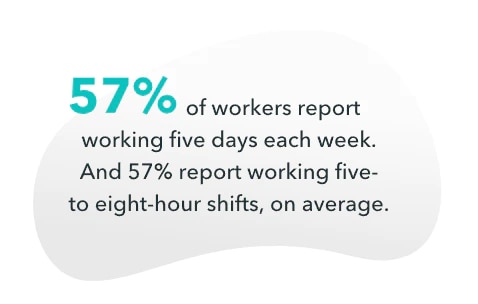
Employees who work five- to eight-hour shifts are the highest percentage of respondents who are satisfied with their schedules, compared to those who work shorter or longer shifts.
Employees who work five- to eight-hour shifts are the highest percentage of respondents who are satisfied with their schedules, compared to those who work shorter or longer shifts.
Most workers say they’re scheduled to work 36-40 hours in an average week.
30% of respondents report working more than 40 hours a week, every week, regardless of the hours they’re scheduled to work. The second-largest group of respondents (28%) report never working more than 40 hours each week.
Overtime rates vary by industry, so employers should benchmark themselves against others in their industry to understand what’s normal and how they compare. Still, nearly a third of workers reporting that they work overtime every week may be concerning. Recent research correlates working longer hours with poor sleep, reduced productivity, and an increased risk of stroke, among other effects.
Types of work schedules
Full-time work schedules
Generally, workers with full-time schedules work at least 35 hours each week, which is how the U.S. Bureau of Labor Statistics (BLS) defines full-time work. The “standard” full-time schedule is 40 hours per week.
Depending on whether they’re exempt or nonexempt from overtime pay, workers who clock more than 40 hours a week may receive additional compensation for overtime work. Typically, the overtime rate is one-and-a-half times higher than a worker’s standard pay rate. Most workers who are exempt from overtime pay are salaried employees.
Typically, full-time employees are eligible for employee benefits such as health insurance, retirement plans, and vacation or sick pay.

Part-time work schedules
Part-time schedules are anything less than a full-time schedule. Certain industries, such as retail and food service, are more likely to employ part-time workers than others.
Generally, part-time workers are not eligible for employee benefits, but some companies offer them to part-time workers. Part-time workers may work a schedule that allows them to address other responsibilities, such as working other jobs, caring for their families, or attending school. These schedules are sometimes referred to as “shift schedules,” which refer to the various shift options an employee can work during the day.

Flexible work schedules
“Flexible work scheduling” doesn’t necessarily refer to the number of hours worked. It refers to the control employees have over when or where they work. For example, employees may have the opportunity to work remotely, work from their homes, or work during flexible time frames. Increasingly, these policies are becoming more popular. Recent research shows that offering flexible scheduling may have a number of benefits for employees and employers.
Fixed work schedules
A fixed work schedule is one where the hours and days worked each week remain consistent. Typically, these work schedules are associated with full-time jobs, wherein employees are expected to work at specific times on specific days. But this could refer to any schedule where the hours and days worked each week remain the same.
Rotating work schedules
Rotating scheduling refers to a practice where employees work shifts that change in alignment with repeating shift patterns. Often utilized when 24/7 staffing is required, this scheduling method is used to avoid having specific employees work undesirable or physically taxing shifts at all times. These more challenging shifts are distributed evenly across the workforce.
Schedule inconsistencies and challenging work hours associated with this type of scheduling can lower employee satisfaction and negatively impact employee health.
Other work schedules
While 9-5 might be considered the standard, there are alternative ways to structure the workweek. Here are some of the more common alternative work schedules:
9/80 schedule. This is a condensed work schedule that gives employees an additional day off during each two-week cycle. For example, in the first week, employees work four nine-hour days followed by one eight-hour day, receiving Saturday and Sunday off. The following week, they work four more nine-hour days and receive Friday, Saturday, and Sunday off.

9-9-6 schedule. This is a work schedule where employees work 9 AM to 9 PM, six days each week, for a total of 72 hours each week. Though seemingly in violation of labor laws in China, it is reported that this schedule is common among employers in the country. The practice received public attention after Alibaba’s Jack Ma made statements supporting it in early 2019.

2-2, 3-2, 2-3 rotating schedule. This is a rotating shift schedule based on a four-week cycle. Four teams work 12-hour shifts to provide 24/7 coverage. Here’s how the four teams are scheduled:
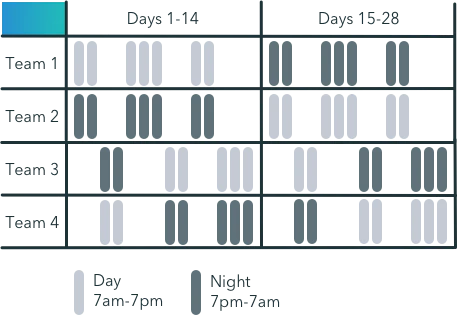
4/10 schedule. This condensed schedule is one where employees work four 10-hour days each week, for a total of 40 hours each week. These workers receive three days off—typically Friday through Sunday.

Why are work schedules important?
Work schedules are important for a variety of reasons. From an employee perspective, a clear, fully prepared schedule can impart freedom and empowerment. Knowing their schedules, workers can make plans for their time off. Employers, too, will find work schedules important—both for their own peace of mind and for cost savings. Published schedules keep employees from accidentally missing shifts and managers from having to scramble to cover the gap.
Qualities of good work schedules

A good work schedule takes into account employee health and wellbeing, consistency, preparation, and balance.
Recently, the New York Times wrote an article about what Gen Z (the latest generation to hit the job market) wants from an employer. A healthy work-life balance was paramount in their decision to accept a job offer. If the people interviewing for jobs want schedules that give them more flexibility, that’s something employers should consider.
Good schedules put employee health first
Asked to rank factors according to what was most important to them in their schedules, the No. 1 factor among respondents was prioritizing their health or sleep. 22% of respondents chose this as the most important factor in their work schedule.
Despite most workers reporting they’re generally satisfied with their schedules, nearly 1 in 5 believe their schedule negatively impacts their health.
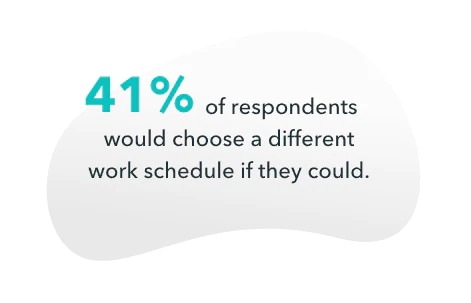
On the bright side, 45% of workers surveyed say that their work schedule fits their preferred sleeping schedule “very well.”
The proportion of workers who report their work and sleep schedules aren’t well-matched (12%) was higher among workers with rotating shift schedules than those with consistent schedules (8%).
Whether they fall late at night or early in the morning, some shifts are harder to work than others. 18% of respondents report always working “bad shifts.” This group of workers also indicate the worst part of their schedule is the impact it has on their sleep or health.
But sleep isn’t the only factor in a healthy life.
The standard lunch break for U.S. workers is 30 minutes. However, 38% of employees report that they “always” or “often” work through their scheduled breaks.
In the interest of supporting employee health, employers should establish clear policies around breaks and lead by example. 13% of North American workers think their co-workers would judge them negatively if they take a regular lunch break, says a lunch study by business hygiene company Tork. However, those who take regular lunch breaks feel more valued by their employers and are more satisfied with their jobs.
Good schedules are consistent
Consistency is the second most important factor in a work schedule, according to workers surveyed.
59% of respondents say they work about the same schedule every week.
27% say their schedules often change from day to day, according to their availability or the needs of the business. 12% report that their schedules change based on weekly shift rotations.
The data shows that dealing with shift rotations may have a big impact on workers’ satisfaction with their schedules. 60% of those on weekly shift rotations say they would choose a different schedule if they could.
On the other hand, only 40% of workers with consistent schedules or availability-based schedules say they’d choose a different schedule if they could.
There is also a correlation between consistent schedules and how long employees have been at their current job. Employees who have consistent schedules report having been at their current job longer than those who have schedules that change from week to week.
67% of workers with consistent schedules have been at their current job for three years or more.
This level of retention is also seen in 62% of workers with availability-based schedules and 51% of workers with rotating schedules.
And while we’ve come a long way since the first American factory instituted a five-day workweek, 6% of respondents say they work seven days a week.
Scheduling to balance work and life
Employees value their time outside of work, especially the hours they get to spend with loved ones.
Survey respondents who say their schedule has a negative impact on their health say the worst part of their schedule is missing time with their loved ones. More than lost sleep, lost time with spouses and kids was the biggest contributor to feeling a work schedule hurt their health and wellbeing.
38% of respondents report spending three to five hours of quality time with loved ones on workdays.
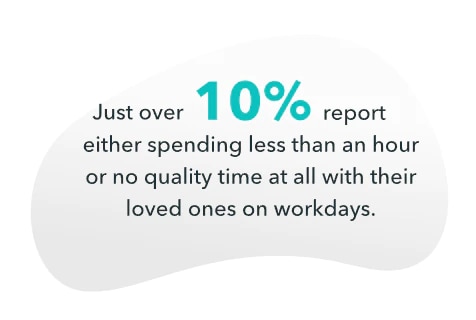
22% of respondents report spending less than an hour on their hobbies or leisure activities during the workweek. The largest group of respondents (30%) reported spending one to two hours on their hobbies.

70% of workers say they typically get weekends off, and most prefer it that way. Respondents who “rarely” get weekends off say their schedule has a negative impact on their life, at a higher rate than those who consistently have weekends off.
But not everyone’s working for the weekend. 28% of workers say they’d prefer to have their days off fall on weekdays.
How schedules impact employee career outlook
We know that consistency, health, and work-life balance are all important factors to employees when it comes to their work schedules. So what is the overall outlook when it comes to how employees feel about their jobs?
Good news, employers:
When asked how long they’d be happy at their current job, the largest segment of workers (22%) say they’d be happy working at their job for more than 10 years.
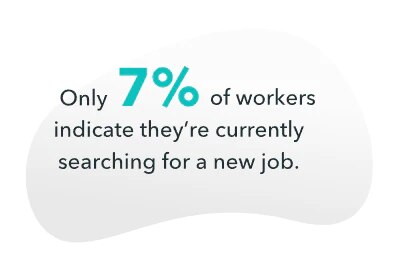
But when asked about their intent to stay, women and men respond differently. While 69% of men say they’d be happy at their jobs three years or more, only 55% of women feel the same.
And while workers may say they’re interested in staying with their employer long term, whether or not they actually do is another question.
Signs are still positive for employers. Nearly a third of respondents (31%) say they’ve worked at their current primary job for more than eight years.
Employees who have been at their current job three to five years made up 24% of respondents. And those who have been at their jobs less than two years made up 21%.
Pay and benefits are among other important factors when it comes to long-term job appeal. But some workers might be willing to trade good pay for a schedule that’s right for them.
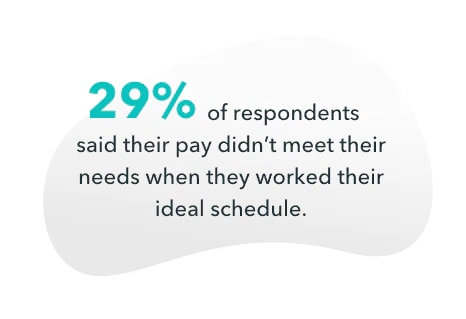
Women and men also responded differently to this question. 23% of men who have their ideal schedule said they think their pay exceeds their needs. Meanwhile, just 15% of women feel the same.
Given 1 in 4 employers has faced legal action over equal pay, this is just another sign that women may have a disadvantage when it comes to getting the schedules and compensation they need. Additionally, the hours women work may make a bigger impact on their lives than the hours men work.
Only 25% of women surveyed are salaried, opposed to 34% of men.
And unfortunately, the data shows that there are still bigger problems to solve when it comes to the relationships between employers and employees.
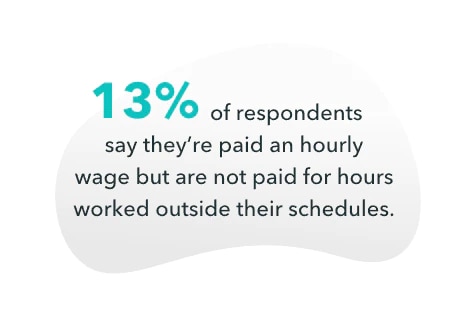
And once again, women and men responded differently. 16% of women say they’re not paid for hours worked outside of their scheduled hours. Only 9% of men say the same.
Depending on the industry, not paying employee overtime could be a violation of the Fair Labor Standards Act (FLSA) and state labor laws.
Additionally, when broken down by income, the highest percentage of respondents who said they are not paid for additional hours worked outside of their scheduled hours fell into the $15,000-$19,999 bracket. This finding indicates lower-income workers are most likely to be victims of wage theft—a fact that’s been upheld in the past by the Economic Policy Institute (EPI).
Low-income workers also see fewer opportunities for advancement and less job stability, control over hours, purpose, and enjoyment than higher-income workers. Only 58% of low-income workers said they’re satisfied with their jobs when it comes to having stable and predictable hours.
Recent legislation pushes us toward more predictability and consistency for workers. And we can see that these factors are priorities for the workers themselves. Using technology, whether it’s employee scheduling software or workforce communication tools, is one way employers can improve the state of scheduling at their business. Research also shows that flexibility around where and when employees work can increase their productivity.
Having some control over schedules may also boost worker satisfaction.

Perhaps the best way for employers to get scheduling right is to get to know their employees. Everyone is different. What makes a schedule good or bad depends on what else an individual has going on in their life. If you want to understand what workers want from their schedules, it’s best to ask.
How schedules impact employee career outlook
We know that consistency, health, and work-life balance are all important factors to employees when it comes to their work schedules. So what is the overall outlook when it comes to how employees feel about their jobs?
Good news, employers:
When asked how long they’d be happy at their current job, the largest segment of workers (22%) say they’d be happy working at their job for more than 10 years.

But when asked about their intent to stay, women and men respond differently. While 69% of men say they’d be happy at their jobs three years or more, only 55% of women feel the same.
And while workers may say they’re interested in staying with their employer long term, whether or not they actually do is another question.
Signs are still positive for employers. Nearly a third of respondents (31%) say they’ve worked at their current primary job for more than eight years.
Employees who have been at their current job three to five years made up 24% of respondents. And those who have been at their jobs less than two years made up 21%.
Pay and benefits are among other important factors when it comes to long-term job appeal. But some workers might be willing to trade good pay for a schedule that’s right for them.

Women and men also responded differently to this question. 23% of men who have their ideal schedule said they think their pay exceeds their needs. Meanwhile, just 15% of women feel the same.
Given 1 in 4 employers has faced legal action over equal pay, this is just another sign that women may have a disadvantage when it comes to getting the schedules and compensation they need. Additionally, the hours women work may make a bigger impact on their lives than the hours men work.
Only 25% of women surveyed are salaried, opposed to 34% of men.
And unfortunately, the data shows that there are still bigger problems to solve when it comes to the relationships between employers and employees.

And once again, women and men responded differently. 16% of women say they’re not paid for hours worked outside of their scheduled hours. Only 9% of men say the same.
Depending on the industry, not paying employee overtime could be a violation of the Fair Labor Standards Act (FLSA) and state labor laws.
Additionally, when broken down by income, the highest percentage of respondents who said they are not paid for additional hours worked outside of their scheduled hours fell into the $15,000-$19,999 bracket. This finding indicates lower-income workers are most likely to be victims of wage theft—a fact that’s been upheld in the past by the Economic Policy Institute (EPI).
Low-income workers also see fewer opportunities for advancement and less job stability, control over hours, purpose, and enjoyment than higher-income workers. Only 58% of low-income workers said they’re satisfied with their jobs when it comes to having stable and predictable hours.
Recent legislation pushes us toward more predictability and consistency for workers. And we can see that these factors are priorities for the workers themselves. Using technology, whether it’s employee scheduling software or workforce communication tools, is one way employers can improve the state of scheduling at their business. Research also shows that flexibility around where and when employees work can increase their productivity.
Having some control over schedules may also boost worker satisfaction.

Perhaps the best way for employers to get scheduling right is to get to know their employees. Everyone is different. What makes a schedule good or bad depends on what else an individual has going on in their life. If you want to understand what workers want from their schedules, it’s best to ask.